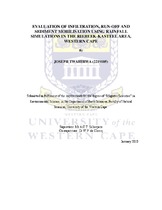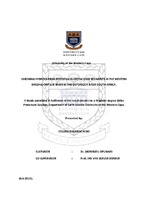| dc.description.abstract | River catchments in agricultural areas are strongly influenced by runoff from cultivated or grazed fields, and nutrient loading of these fields can result in large quantities of nitrates and phosphates being transported to rivers in surface runoff. In intensively farmed areas, nutrient loading is often so high that large quantities of nitrates and phosphates are transported to streams in surface runoff. Within these areas, strips of natural riparian vegetation and wetlands are critical in providing nutrient uptake functions that can reduce the load entering streams. A wetland can be a source, sink or transformer of nutrients, where fine sediments such as silt and clay have the ability to store and trap considerable amounts of phosphorus through adsorption and precipitation processes. Therefore, the determination of phosphorus adsorbed to fine sediment is important in understanding the role and value of wetlands in agricultural landscapes, and is the main focus of this study. The aim of the study is to evaluate an indicator-based approach, WET-EcoServices, to assess wetland sediment and phosphate trapping, through comparison with field survey data. The study focuses on spatial analysis and field survey of three Hydrogeomorphological (HGM) units classified for the Wiesdrift wetland on the Nuwejaars River, Cape Agulhas. The three HGM units are classified as: a floodplain wetland at the inlet of the system, a channelled valley-bottom wetland towards the middle part of the system and a floodplain wetland towards the outlet of the system. In-field observations were recorded for hydrogeomorphic and vegetation characteristics for each HGM Unit. AstroTurf mat sediment samples, grabbed channel bed and floodplain sediment samples were analysed for particle size and orthophosphate concentrations, while suspended sediment masses were recorded from three pairs of time-integrated sediment samplers located near the inlet, near the middle, and near the outlet of the wetland. Statistical analysis showed that orthophosphate concentrations are associated with fine sediment. Thus, the orthophosphate concentrations follow the distribution of silt on the Wiesdrift wetland. The dominant vegetation along transect 2, at which the highest concentrations of orthophosphate was found, is occupied by Typha capensis and Cyperus textilis. The percentage of fine sediment (silt) ranged between 0-37%, where the remaining percentage was sand. There was also a significant positive correlation between orthophosphate concentration and silt (Spearman’s rank-order correlation: rs = 0.692, N = 70, P < .001). The largest total sediment amount was found at Outlet 1 and Outlet 2 in the HGM unit 3 of the Wiesdrift wetland, with a value of 0.653 g. Overall, orthophosphate concentrations ranged between 0 mg/kg and 31320 mg/kg within the Wiesdrift wetland. WET-EcoServices determines an average score for phosphate trapping from on-site indicators such as hydrological zones, vegetation structure and soil texture/permeability. The dispersal of fine sediment and associated adsorbed phosphate is more complex than can be determined by a tool like WET-EcoServices because the tool captures the long-term mean conditions of a wetland system that determines the overall uptake of phosphates over extended time periods, thus future wetland assessments is recommended to take place over a longer period than this study. However, the field results of orthophosphate distribution are generally consistent with the findings from WET-EcoServices, further motivating for the use of the tool in wetland management applications. | en_US |




